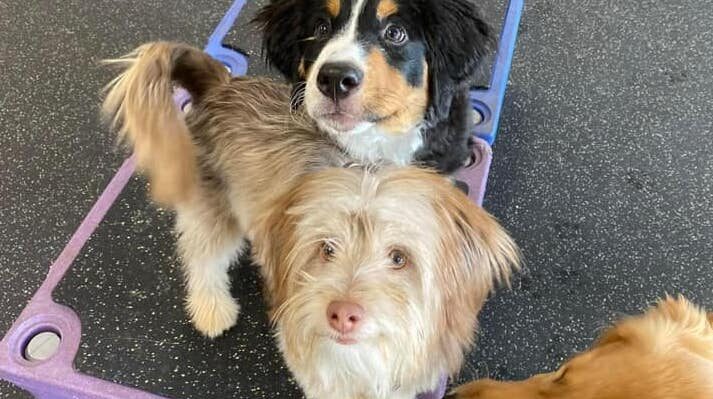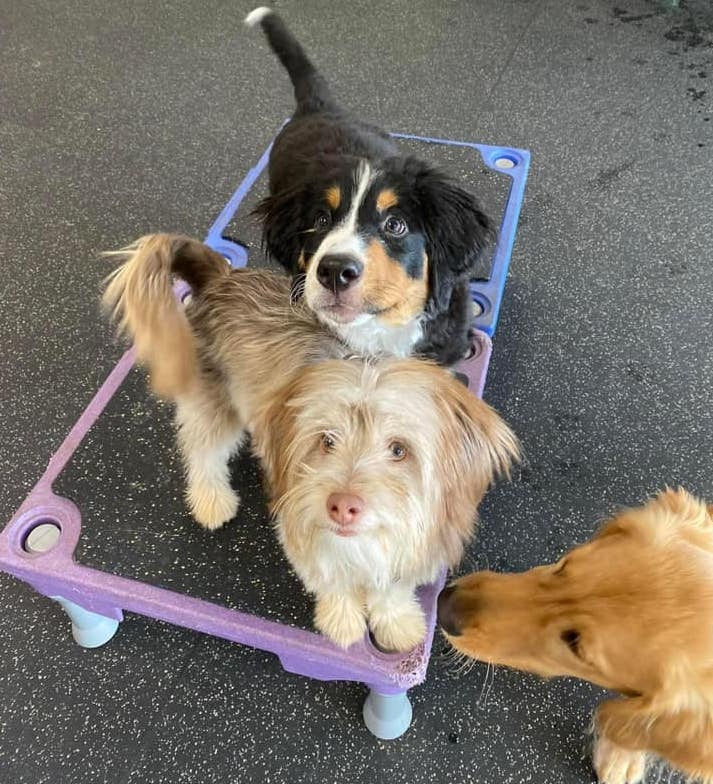
Last week, we asked the question, “Is Puppy Class Important?” Friends who are dog professionals and experienced dog guardians answered, sharing their experiences and opinions.
This week, a trainer and instructor in the United Kingdom offers guidance on how to find the best puppy class for your pup. Here is what Stephanie Presdee shared with us:
Stephanie Presdee (United Kingdom) A lot of trainers and training clubs offer puppy classes, and most of the time it is a great idea to enroll on a puppy course to give your new pup the best start in life. He will not only learn some useful obedience exercises, but will also get to know various people and other puppies, which will greatly aid his socialization. However, not all puppy classes are the same; it is vital that you choose the right one for your pup, as going wrong at such a sensitive time can have a detrimental effect on your pup’s behavior. Maybe choose a one-to-one training session first to see if you ‘gel’ with the trainer and you are happy.
Here are a few simple guidelines to help you choose the best puppy class for your pup:
1. A good puppy class has a limited number of pups attending; you can’t just show up on the day with your puppy. This ensures that you won’t end up being in a crowded room with 20 other noisy barking pups and owners, trying to concentrate on what the instructor is saying or doing, and finding it all very distracting. There is no ideal number for puppy classes—it all depends how big the venue is and how many instructors/helpers there are available. Four to six (eight maximum) is probably the number you should be looking at. And it should be a calm atmosphere!
2. There should be an upper age limit for attending pups. Puppy classes aid the socialization of puppies, not just obedience exercises. I love handling, but NOT off-lead puppy play. Dogs that have started maturing sexually might find the way puppies play—typically a bit rude from a doggie-etiquette point of view—too much, and react aggressively. Also, older dogs might not tolerate being handled by strangers too well, which could potentially result in displays of aggression (not so common in young puppies).
If the trainer uses a demo dog, it should not wander about off-lead going into your handbags or interfering with your dogs or even an assistance dog. I actually saw this happen at a local gun-dog demo!
Check that the hall looks clean and smells clean, not of dog pee. Most clubs put down water bowls. Check if they are clean, changed frequently, or slobbery. I am not a fan of shared bowls. Take your own bowl if in doubt. Puppies can get bad tummies even from a change in water. Add travel to that and the stress, treats used in training, and a strange place and other dogs? A recipe for upset tums.
Do not let a trainer give your puppy food rewards unless you know what they are. You might not want sugar-loaded shop-bought treats being given. The trainer should always ask if your puppy/dog is allergic to anything that you are aware of.
Clubs letting puppies off leads on slippery floors, with their hall doors open into car parks or onto lanes/roads, or people going in and out unsupervised, are definitely off the “good” list.

Photo by Sarah Richardson
3. If the puppy class you are attending includes off-lead puppy play, puppies should not be let off the lead all at once. Even when very young, not all pups are the same. They differ greatly in size—it isn’t uncommon to have a big Labrador pup and a Chihuahua in one class—so they can inadvertently scare or injure each other. They will typically be of various ages, so some might be slightly more bouncy or better coordinated than others. They will play differently, depending on their breed and experience. Typically, pups that live and play with adult dogs might be a bit rougher in their play than those that live on their own; similarly, some breeds might present a play style that will be very intimidating for other breeds. E.g., a bouncy, barge-y boxer will be a bit too much for a slim whippet pup.
When you ask about puppy play, ask how many pups are off lead at the same time and whether they are grouped according to certain criteria. And whether the floor is suitable. Ask, “Are they supervised?” It has to be structured. Controlled meet-and-greets are a better way to learn. Puppies do not learn much from other puppies running free. I have walked out of a club where my puppy Borzoi was expected to run off lead with a GSD and two Border collie adolescents playing roughly.
4. Training methods used during the class should be positive only (using food and toys and praise to teach the pups basic cues and to get them used to handling). No choke chains, rattle bottles, water sprays, squeezing the pup’s front legs for jumping up, or rolling them on their back to show them who is boss. All these methods can be very scary and highly aversive for any dog, not to mention a tiny, sensitive pup. If such punitive methods are used on a pup when there are other dogs around, this might additionally pave a way for your pup to develop fear aggression, as he will associate other dogs with the unpleasant experience. An opposite effect to what you intended!
5. Let’s not forget about the class instructor: only attend classes run by professionally qualified insured instructors who (a) are approachable and happy to answer any questions you might have, (b) have their qualifications and insurance there for you to see, and (c) are transparent about where they did their courses and their continual professional development, including on their web pages.
If they sound as if they don’t exactly know what they’re talking about, walk away. Owning a new pup, whether it’s your first puppy or you’ve had dogs before, can sometimes throw things at you that you never expected could happen. Your instructor should be able to help you with these problems. If they don’t know the answer, they should refer you to someone who is likely to help—a vet or a dog behaviorist.
People learn in different ways. There should be demos, hand-outs, back-up emails, maybe some videos. However, it does pay to listen to the instructor/s during class, not to chat among yourselves! At the end, there should be question time. That’s not when trainers should be rushing off to get home—they should set aside the time to see students individually.
A good instructor will also be up to date with current knowledge on dog behavior. You shouldn’t hear from them any talk of dominance, pack leaders, or alpha rolls, which all belong to the “old school,” long-debunked training methods that are not used or popularized by trainers who keep current with research and new developments in the field of canine behavior and training.
It’s hard to teach everything in an hour or less, and classes will end with the puppy and owner not learning if the owners do not put in the practice at home.
Also hard for instructors: teaching a positive, force-free approach and member/s of the household not wanting to change their ideas from the old military or police method of training. The household must be consistent in their methods and cues to give the puppy a chance. Make sure the family are all on the same page!
Emails and phone chats before the course starts should make clear how puppy training is approached. An owners’ get-together evening with no dogs may be hosted by some clubs before the course.
6. Don’t forget to observe a class before enrolling your pup on the course. Most good instructors will have nothing against your sitting and watching the class, as they will have nothing to hide.
If they are reluctant for you to come and watch, you’re better off walking away and looking for an alternative option. When observing the class, particularly if it is the end of a course or a certificate award night, pay attention to how the puppies and owners are acting. Are the pups looking at their owners, bright, alert, and enjoying themselves, or do they seem to be intimidated by the instructors? Do the pups seem stressed? If the pups are stressed and/or intimidated, there will be cowering, hiding under chairs, reluctance to work, panting, flat ears, and tails tucked under bellies. Relaxed pups will have their tails up and wagging in a sweeping way, bright eyes, looking around confidently.
7. Research PACT trainer lists, PPG lists, APDT trainers near you. There are others; it depends whether you want a happy-clappy type class or want some serious up-to-date info coming your way.
Don’t always go for the cheapest nearest option. Sometimes classes that are too cheap also offer low-quality service, as the trainer doesn’t invest in continuous professional development (or paperwork and handouts), or their venue is cheap to hire and so not always suitable for running puppy classes, with smelly, dirty areas/fields—and no loos!
8. Vaccinations in the UK are not mandatory. It was our choice to accept puppies before long drawn-out vaccination courses had finished, as we felt that it was more important for puppies to receive socialization before they were fully vaccinated, and we accepted homeopathic nosodes. As our demo dog and our own dogs had been treated this way and were raw fed, we felt it only fair not to be hypocritical. I started my club in 1980 and have never had a report in all those years of a puppy’s being ill as a result of the class attendance.
NEXT WEEK: A trainer and instructor in the United States says, “Puppy class is the most important class in the life of any dog.” She’ll share her opinions on what to look for in a puppy class … and what to avoid.



